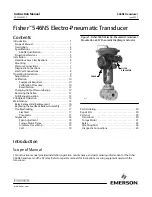
BA_078_en_10.01 Level transmitter PASCAL Ci4 LEVEL
Page 25/36
When you set the position correction, it will be activated automatically. You can deactivate
the position correction, for instance for a subsequent calibration to check the zero point
independently from the installation position.
6.5.4.3
Upper and lower adjustment
The lower adjustment results in an offset of the characteristic curve. It thus affects zero
and span of the measuring range.
The upper adjustment changes the slope of the characteristic curve by correcting the span
of the measuring range.
Execute the lower adjustment prior to the upper adjustment for a correct full adjustment.
Figure 23: Effect of the upper and lower adjustment on the characteristic curve
You can perform the upper and lower adjustment at any reference pressure level. For in-
stance, you can perform the lower adjustment of a -
1…4 bar device at -900 mbar rel. The
reference pressure level for the upper offset can also be freely chosen. To ensure that the
adjustment is as precise as possible, the upper and lower adjustment should be performed
as close as possible to the lower range value and upper range value of the measurement
ranges.
6.5.4.4
Current adjustment
You can use the current adjustment, if the reading at the end of the measurement chain
(re-converted current value) does not correspond to the measured pressure. With this
function you can compensate deviations in the output stage as well as the downstream
measurement chain.
Proceed as follows (example for 4 mA):
Select function "Current adjustment"
–> "4mA"
Use "OK" to activate constant current mode (4 mA). CAUTION! The output current
value now no longer corresponds with the measured pressure! This is indicated by
the icon "Function check" (see 6.3.3).
Read the displayed current value at the end of the measurement chain.
Enter this current value (e.g. 3.996) at the device. The device now corrects the cur-
rent output so that 4 mA are shown at the end of the measurement chain.











































